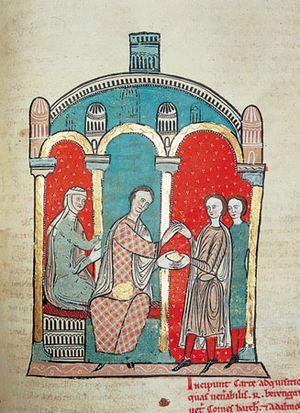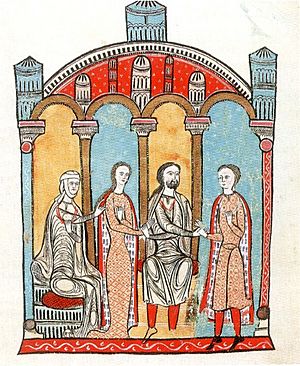Liber feudorum maior facts for kids
The Liber feudorum maior (say "LEE-ber FAY-oo-door-oom MY-or"), often called the LFM, is a very old and special book from the late 1100s. Its name is medieval Latin for "great book of fiefs." A fief was land given by a lord to someone in exchange for loyalty and service.
This book was originally called the Liber domini regis ("book of the lord king"). It was put together by a royal record keeper named Ramon de Caldes, with help from Guillem de Bassa. They started working on it in 1192 for King Alfonso II of the Crown of Aragon.
The LFM holds 902 important documents, some dating back to the 900s. It's also filled with beautiful pictures in a Romanesque style. This is quite rare for a book of official records. The LFM is a key source for understanding the history of the Principality of Catalonia. You can find it today in the Arxiu de la Corona d'Aragó (ACA) in Barcelona.
Contents
What is the Liber Feudorum Maior?
A Royal Record Book
The LFM is a type of book called a cartulary. A cartulary is a collection of copies of original documents, like legal papers, land grants, and agreements. Kings and nobles used them to keep track of their rights and properties.
This book helped King Alfonso II manage his lands and the people who held them. It was like a giant filing cabinet for all his important papers.
History of the Book
How the Book Survived
Only 114 of the original 888 pages of the LFM are left today. However, only 93 of the 902 documents are completely lost. This means experts can still figure out almost everything that was in the book.
The person who wrote the introduction, Ramon de Caldes, said the book was in "two volumes." But the way it's divided now is from when it was rebound in the 1800s. We don't know if the second volume was ever finished or even started.
The original books were damaged during the French Revolution and the Peninsular War (when France invaded Spain). Luckily, the lists of contents (one from 1306) survived. Most of the original paper documents that were copied into the LFM also still exist.
A modern editor, Francisco Miquel Rosell, used these clues to put the documents back in their correct order. However, the pages were trimmed, so we can't see how they looked before.
Other Related Books
Two smaller books of fiefs are also connected to the LFM project. The Liber feudorum Ceritaniae focuses on the areas of Cerdanya and Roussillon. It might have been an attempt to create smaller, local record books like the LFM.
The Liber feudorum formae minoris is a continuation of the LFM. It includes documents from the early 1200s. Only two other similar record books from this time exist. They are the Liber instrumentorum memorialium and the Liber instrumentorum vicecomitalium.

Why and How it Was Made
When it Was Put Together
The LFM was likely created because King Alfonso wanted more control over the powerful castle owners, called castellans, in his lands. From 1178 to 1180, he started many lawsuits to gain access to various castles. The LFM was the result of a lot of research into the royal archives to support the king's claims.
Some historians believe the book was finished and given to King Alfonso II in August 1194. This was around the same time that a powerful noble, Ponç III de Cabrera, made peace with the king. Ramon de Caldes, who worked on the book, was last recorded working on it in April 1194. This suggests he worked hard to finish it quickly.
Another idea is that the LFM was mostly finished by 1192. A few documents from after 1192 were added later by different scribes. These documents mainly concern Ponç de Cabrera and his loyalty to the next king, Peter II.
What Was Its Purpose?
The LFM was more than just a list of properties. It showed a new, stronger idea of royal power. It helped the king prove his rights over a large area. This area included Aragon, parts of southern France (like Carcassonne and Béziers), and all the Catalan counties.
The book was not just about joining Catalonia and Aragon. Instead, it showed the king's authority over many different regions. These included lands he already owned, like Ausona and Barcelona. It also included lands he did not fully control, like Empúries and Urgell.
Historians like Thomas Bisson say the LFM was mainly a "land book." It focused on who owned what and who had rights to land. However, Adam Kosto believes it was also a "case book." This means it showed how the feudal system should work correctly.
The way the book was organized showed the different statuses of the regions. Aragon was called a regnum (kingdom). Cerdanya and Roussillon were comitati (counties). Tarragona was a civitas (city). This shows the complex mix of lands under the king's rule.

What's Inside the Book?
How the Text is Organized
The documents in the LFM are grouped by county, by areas ruled by a viscounty, or by family lineage. These groups were often linked to a specific castle or estate. Sections and subsections were sometimes marked by special titles called rubrics.
Blank pages were left between sections. Some thought these were for older documents that hadn't been found yet. Others believed they were for adding new documents later. In fact, both new and old documents were added to these blank pages. Within each subsection, the documents are usually in time order.
The king's official records were first mentioned in 1180. Ramon de Caldes wrote about "all of your own documents and those drawn up between you and your ancestors and your men." We don't know exactly where these documents were kept. They might have been in one central place, or in smaller archives in different towns.
For example, the records sent by Ramon de Gironella to Guillem de Bassa were mostly about the County of Girona. The people copying the LFM might have traveled around the king's lands to collect or copy documents. Some documents in the LFM definitely came from outside sources. For instance, 109 documents from the County of Pallars Jussà were added almost immediately after King Alfonso gained control of that area in 1192.
The Amazing Pictures

The LFM is special because it has many beautiful pictures, called miniatures. This is rare for a book of official records. However, it's not the only one from the 1100s, even in Spain. There are four Spanish examples from the early 1100s.
The LFM still has 79 images, but it used to have more. Many of these pictures show specific actions related to the feudal system. For example, they show the act of homage (hominium). This is when a vassal (someone who owes loyalty to a lord) places their hands between their lord's hands.
Oaths and promises are shown by people raising their right hands. Agreements are shown by people holding hands. The Treaty of Zaragoza (1170) is pictured with King Alfonso II and King Alfonso VIII of Castile sitting on two thrones and holding hands. All these pictures helped show the king's power and how vassals were expected to obey him.
However, the first two pictures in the book are a bit different. In the first, King Alfonso and Ramon de Caldes are sitting at the same level. A scribe is working in the background. The main focus is on the pile of documents. This shows the king as someone who works hard to manage his kingdom.
In the second picture, the king and queen, Sancha of Castile, are surrounded by seven pairs of noblewomen talking. The king and queen also seem to be talking. This picture probably shows the royal court and its culture. It was a place where many troubadours (poet-musicians) would perform.
See also
 In Spanish: Liber feudorum maior para niños
In Spanish: Liber feudorum maior para niños


